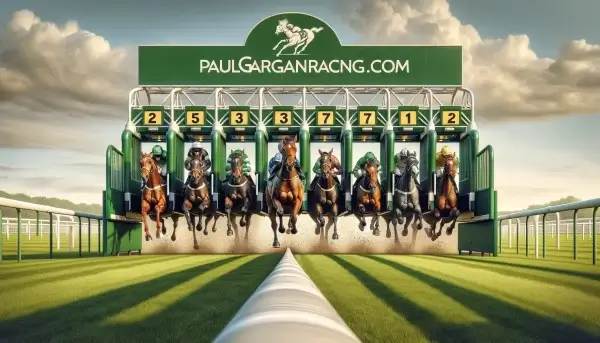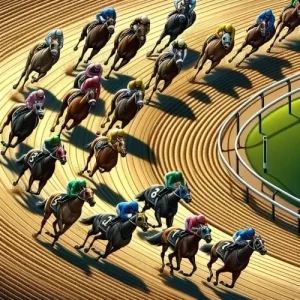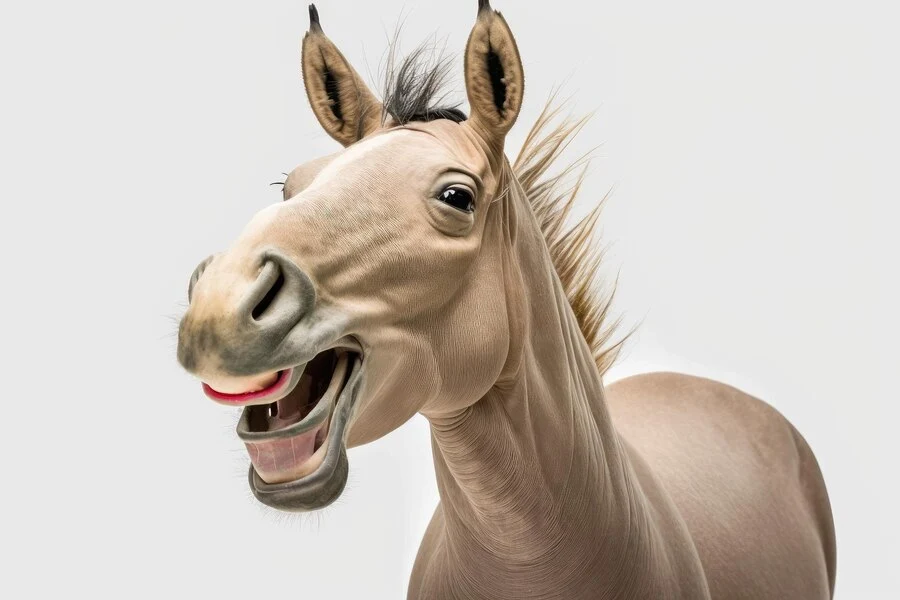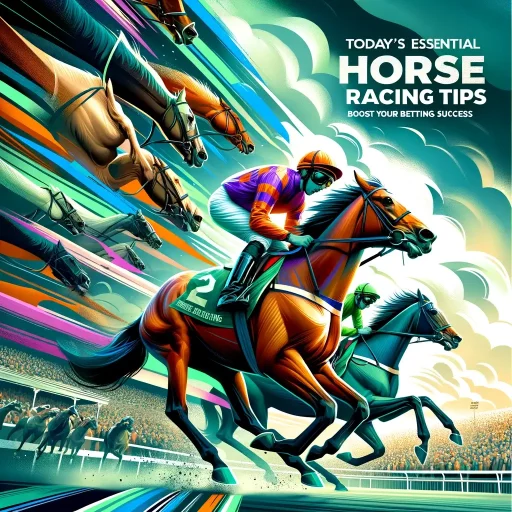
Understanding The Draw in Horse Racing
Want to learn more about the draw in horse racing?
Surprisingly, 91% of horse racing enthusiasts and punters regularly overlook one highly-important factor when choosing a bet: the draw.
In a game where every second counts, understanding the draw’s impact is a game-changing aspect that can turn the tables in your favour.
The difference between your horse winning and losing a race might be as small as a milimetre. So if you’re serious about winning, it’s important to learn about the draw in horse racing.
The difference that a good draw or a bad draw makes might be the difference to a pocket full of cash, or an empty one.
Read more about how the draw works in horse racing and how you can try to stay on the right side of the draw bias whenever there is racing in the UK or Ireland.

What is the Draw?
The term ‘draw’ in horse racing may sound obscure if you’re a beginner. However, it’s an integral part of racing jargon that you’ll hear every time there is a flat race. ‘The draw’ refers to the gate number a horse is allocated in the starting stalls for a flat race. Note: it’s important to know that there are no starting stalls used for jumps or National Hunt Racing in the UK and Ireland. As such, the entire concept of the draw is irrelevant to those races. But if you want to learn about the impact of the draw on flat races, on turf or the all-weather, then read on. The draw a racehorse get can significantly impact performance and race outcome. This depends on numerous factors such as the course layout, the distance of the race, and the ground conditions. It also depends on the horse’s running style, the racing style of his opposition, and the way the race pans out after the stalls open. Because of all these factors, a horse’s draw position, low or high or even somewhere in the middle, can have a vast impact upon its chances in the race.The Making of the Draw
Understanding the draw isn’t just about knowing its implications, but also about appreciating how stall positions are determined. The draw is conducted via a random lottery system after the declaration stage. This ensures an unbiased draw, adding to the unpredictability and excitement of the race. However, some racing events in some countries do allow trainers or owners to select their desired stall based on the order of a separate draw, adding an additional layer of racing strategy to the process.Why is the Draw in Horse Racing Important?
To really understand the draw’s importance, think of it as the starting point of a human relay race on a typical 400m running tack. The athletes closer to the inside have a shorter distance to run than those starting farther out. That is why the start of these races, and any race around a bend under 1000m, has a staggered start line. The wider your lane, the more of a start you are given. This offsets the advantage of the inside lane runners to keep the race fair for all competitors. Similarly, in horse racing, a lower draw (usually closer to the rail) often allows the horse to cover a shorter route, potentially conserving energy, which could prove decisive in a close finish. However, the advantage of a low draw can also be a double-edged sword. A horse in this position can risk getting trapped on the rail without a clear path to surge ahead if any horse gets ahead of it. On the contrary, a high draw, which positions the horse farther from the rail, might provide a clearer run, keeping the horse away from the bustling traffic of competing horses. Yet, it might require covering a longer distance, using more energy. And most importantly, there is virtually no instance of a staggered start in horse racing. The starting stalls are a straight piece of equipment. So on a turning course, those drawn closer to the inside running rail will have less distance to run than their wider drawn opponents, assuming they hold their position close to the rail.Weather and Track Conditions: A Game Changer for the Draw
One might believe that the draw’s impact remains static, but this couldn’t be farther from the truth. Weather and track conditions can dramatically alter the draw bias. For instance, rain can make the ground heavy on certain parts of the track, favouring horses drawn on the other side. The effects of weather on the racecourse are profound enough to turn an ordinarily advantageous draw into a disadvantage and vice versa. Some racecourses have uneven drainage and cambers, and many have streams, rivers, ponds, reservoirs or other water bodies nearby that affect water run-off. Additionally, many racecourses have hedgerows, bushes or trees bordering the course. These plants naturally soak up water, meaning their root systems can dry ground out faster and create a draw bias. Knowledgeable punters often keep a close eye on weather forecasts leading up to the race. They also know which racecourses and race distances are most likely to be affected following wet periods of weather.Hearing from the Experts: The Draw’s Impact in Their Words
To gain more insight into the draw’s influence, we sought the perspectives of industry veterans. Legendary jockey Frankie Dettori had this to say: “At certain tracks, a good draw can provide a significant advantage. It’s about understanding the unique character of each racecourse and using it to your benefit.” Trainer John Gosden echoed a similar sentiment: “In horse racing, every small edge counts, and the draw is undoubtedly one of those edges. It’s a piece of the puzzle that, combined with a horse’s form, the jockey’s skill, and the race conditions, can help you form a winning strategy.” These quotes from two of the greatest racing figures of the past 20 years make it clear that the impact of the draw is something everyone in horse racing pays attention to.The Draw Importance on Different Racecourses
Each racecourse has a unique layout, and the significance of the draw can vary a lot. For example, on straight courses, the draw might have a negligible impact on results. But a similar looking racecourse might show a distinct draw bias, due to it’s own unique characteristics. Sometimes this can just be due to slight differences in slope or undulations in the course. It might also be related to something as obscure as the way the sand on the course is harrowed between races. In contrast, on round tracks where the first turn comes quickly, a high draw might be more advantageous, allowing the horse to steer clear of the jostling pack and secure an unhindered position by scooting around them. Likewise, some turning tracks with a fair, even bend might suit horses drawn on the inside of the stalls. The fairness of the track might mean horses in these gate positions have very little disadvantages, and benefit from taking the shortest route. Think of the inside lane on an athletics track. There’s a good reason why the start is staggered for every race with a bend. Expert racing websites like RacingPost offer invaluable insights into how the draw impacts horse races at different racecourses. Horse racing experts build up a deep understanding of which draws work at different courses. And ultimately, which suit horses with varying racing styles.Beyond the Bias: Exceptional Races Where the Draw Made All the Difference
History is filled with instances where the draw made a remarkable difference in the race outcome. Take the unforgettable 2001 Nunthorpe Stakes, where the horses drawn on the far side (high numbers) had a distinct advantage due to softer ground, leading to an unlikely victory for the 20-1 outsider, Bahamian Pirate. This illustrates that understanding the draw and its dynamics can be a deciding factor in identifying dark horses (no pun intended) in races.Using the Draw in Horse Racing to Your Advantage
The draw isn’t an absolute determining factor in horse racing but rather an influential one, among many others. But here is an interesting stat:91% of regular gamblers admit to ignoring the draw when choosing their bets.
This is a real indicator of the lack of care that amateur and hobby gamblers can demonstrate. Knowing how the draw affects races over the course and distance of a given race, is absolutely vital information to make good horse racing selections. Knowledge is power in the world of horse racing, and understanding the draw brings you one step closer to making an informed betting decision.Does PGR Use the Draw When Choosing Bets?
At PGR, we firmly believe in an evidence-based approach to betting. The draw forms an integral part of our horse racing form analysis alongside other crucial factors. By incorporating a thorough examination of the draw, we offer you meticulously selected betting options, aiming to maximise your chances of success. Having a fundamental understanding of the draw, and the experience to consider it’s implications accurately is a key component of being an elite horse racing punter. Horse racing statistics going back 20 years help underpin our draw analysis work, and are a vital part of making betting pay. Join the PGR Gold service to back well-drawn horses on a daily basis.Embrace the Power of the Draw Today
Ready to join the 9% who harness the power of the draw in their betting strategy? PGR is here to assist you on this journey, providing expert racing analysis based on a comprehensive understanding of the draw. Sign Up for our Gold Service here! Equip yourself with the knowledge of the draw and make it your secret weapon in the exciting world of horse racing. After all, in a sport where small margins matter, every bit of information counts!Join The UK's Premier Horse Racing Tipster Service
PGR Gold
£29pm
- UK's #1 Racing Service
- 2-4 tips each day
- Recently reduced from £89pm
- For anyone that bets regularly
★★★★★ 4.9 Review Score
PGR Platinum
£1,499/yr
- Full Gold Service, plus
- Special Bets worth £1,482
- VIP Bets worth £4,082
- For anyone serious about making money
★★★★★ 4.8 Review Score
The UK’s most successful private horse racing tips service. Established in 2001. Over two decades of success. Improve your profits and the outcome of your horse racing betting today.



